|
This
picture gallery summarizes the biota found under beachrock overhangs at
Playa Estacion, Puerto Penasco, Sonora, Mexico.
It should
be used to complete lab activity 9.2.
|
Leucetta
losangelensis
|
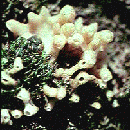 |
"Breadcrumb
sponge"
| Phylum |
Porifera |
| Class |
Calcarea |
| Order |
Leucosoleniida |
| Family |
Leucosoleniidae |
|
| Morphology |
Typically
small and white, with a fingerlike growth pattern and large
excurrent pores (oscula). Its calcareous rods in its skeleton
makes this sponge rough and sandpapery to the touch. |
| Feeding |
Filter feeding |
| Defense |
Unpalatable |
| Reproduction |
Asexual budding
and sexual spawning |
| Habitat |
Rocky intertidal.
Found in narrow crevices between boulders and also under rocks. |
| Distribution |
Southern California
to the Gulf of California |
| Other |
Most common
calcareous sponge of the Gulf of California |
|
|
Geodia
mesotriaena
|
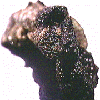 |
"Fuzzy
gray sponge"
| Phylum |
Porifera |
| Class |
Demospongiae |
| Order |
Choristida |
| Family |
Geodiidae |
|
| Morphology |
Its
color varies from white, gray, brown to purple on the outside
and white or pale cream inside. The sponge spreads laterally
into a massive cake, often forming very large colonies. Topped
by leathery with many excurrent openings (oscula).
A distinctive
feature of this sponge is that the large pores(oscula) are restricted
to sieve plates, which are leathery discs about 2-3 sm in diameter,
with many openings. Its internal chambers shelter many other
creatures including small porcelain crabs, brittle stars, and
segmented worms. |
| Feeding |
Filter feeding |
| Defense |
Unpalatable |
| Reproduction |
Asexual budding
and sexual spawning |
| Habitat |
Lives in the
lowest tidal area under boulders. |
| Distribution |
From southern
Alaska to the Gulf of California. |
| Other |
Predators are
few including some nudibranchs and brittle stars. Its internal
chambers shelter many other creatures including small porcelain
crabs, brittle stars, and segmented worms. |
|
|
Tethya
aurantia
|
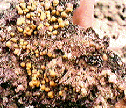 |
"Golf
ball sponge"
| Phylum |
Porifera |
| Class |
Demospongiae |
| Order |
Hadromerida |
| Family |
Tethyidae |
|
| Morphology |
Golf-ball
shaped, yellow-orange, warty sponge. It has root-like processes
at its base that attach it to rock surfaces. Inside it has tough
fibers that radiate out from the center. One to three inches
in diameter. |
| Feeding |
Filter feeding |
| Defense |
Unpalatable |
| Reproduction |
Asexual budding
and sexual larval production |
| Habitat |
On the undersides
of rocks, rocky overhangs, caves and crevices in the lower intertidal
and shallow subtidal |
| Distribution |
Throughout the
world's oceans including the Gulf of California |
| Other |
Contain a layer
of symbiotic algae just below their surface |
|
|
Aglaophenia
diegensis
|
 |
"Ostrich
plume hydroid"
| Phylum |
Cnidaria |
| Class |
Hydrozoa |
| Order |
Hydroida |
| Family |
Plumulariidae |
|
| Morphology |
Delicate
yellowish-tan to brown feather-like plume that grows singly
or in small clumps. Each plume has a center ridge to which a
few small seed-shaped reproductive bodies are attached. Grows
tall to 150 mm. |
| Feeding |
All polyps share
a common hollow gut for digestion. |
| Defense |
Has stinging
cells that when touched, are irritating. |
| Reproduction |
The thickened
parts on the individual stalk indicate mature gonozoids which
repture and release medusae into the ocean. When the medusae
reproduce, the larvae settle to the bottom, attach and become
ostrich plumes again. |
| Habitat |
Growing around
the edge of a tidepool attached to rocks, shells, ledges, and
pilings. |
| Distribution |
Alaska to Ecuador
and throughout the Gulf of California |
| Other |
Most common
intertidal hydroid of the Gulf of California |
|
|
Bunodosoma
californica
|
 |
"Warty
anemone"
| Phylum |
Cnidaria |
| Class |
Anthozoa |
| Order |
Actiniaria |
| Family |
Actiniidae |
|
| Morphology |
Large
and solitary. Brownish-red or orange - tenacles may be red,
brown or green. Its column is covered with bumps or warts randomly
placed. |
| Feeding |
Paralyzes its
prey with stinging cells in their tentacles. |
| Defense |
Can release
stinging cells (nematocysts) and will retract when touched. |
| Reproduction |
Spawning |
| Habitat |
Rocky intertidal
areas. |
| Distribution |
Gulf of California,
Baja ranging to Bahia Magdalena. |
| Other |
Perhaps the
most abundant large anemone found in the gulf. |
|
|
Octopus
fitchi
|
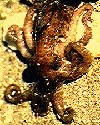 |
"Fitch's
octopus"
| Phylum |
Mollusca |
| Class |
Cephalopoda |
| Order |
Octopoda |
| Family |
Octopodidae |
|
| Morphology |
Small,
reddish brown octopus with an elongate body 0.5 to 1.25 inches
long with 8 arms 2.5 to 3 times the length of the body. |
| Feeding |
Carnivorous
on invertebrates especially crabs and other crustacea |
| Defense |
Can change color
to match its background and can hide in cramped spaces. Can
swim by jet propulsion and can bite. |
| Reproduction |
Male transfers
sperm to female using a specialized arm. Female deposits eggs
singly on undersides of rocks. Planktonic larvae. |
| Habitat |
Under rocks
in the subtdial and intertidal |
| Distribution |
Northern Gulf
of California |
| Other |
Has a reputation
for biting and some people may be allergic to its salivary venom. |
|
|
Bugula
neritina
|
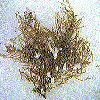 |
"Bushy
moss animal"
| Phylum |
Bryozoa |
| Class |
Gymnolaemata |
| Order |
Cheilostomata |
| Family |
Anascidae |
|
| Morphology |
Pale
to dark reddish-brown or purplish erect and branching bryozoan
that is bushy. The bushes are colonies. Each branch is composed
of many tiny skeletal boxes each which houses a tiny tentaculate
individual. |
| Feeding |
Filter Feeding |
| Defense |
Individuals
can withdraw into their hard skeletal boxes. |
| Reproduction |
Fertilized eggs
are held in brood cells. Larvae are released into the plankton. |
| Habitat |
Intertidal to
subtidal |
| Distribution |
Throughout the
world's oceans including the Gulf of California |
| Other |
|
|
|
Watersipora
arcuata
|
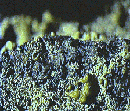 |
"Encrusting
moss animal"
| Phylum |
Bryozoa |
| Class |
Gymnolaemata |
| Order |
Cheilostomata |
| Family |
Microporellidae |
|
| Morphology |
Black
encrusting bryozoan with red fringe. The flat encrustations
are colonies composed of many tiny skeletal boxes each which
houses a tiny tentaculate individual. |
| Feeding |
Filter Feeding |
| Defense |
Individuals
can withdraw into their hard skeletal boxes. |
| Reproduction |
Fertilized eggs
are held in brood cells. Larvae are released into the plankton. |
| Habitat |
Intertidal to
subtidal |
| Distribution |
|
| Other |
|
|
|
Othilia
tenuspina
|
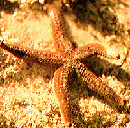 |
"Black-tipped
starfish"
| Phylum |
Echinodermata |
| Class |
Asteroidea |
| Order |
Spinulosa |
| Family |
Echinasteridae |
|
| Morphology |
Brownish-gray
with dark red-black tipped rays, the ventral side is yellowish-orange.
On the rays are small spines. |
| Feeding |
They invert
their stomachs, engulf their prey, and begin the digestion process
while their stomach is still outside their body. |
| Defense |
A creamy fluid
is secreted from pores in the rays when the animal is disturbed. |
| Reproduction |
A synchronized
release of sperm and eggs into the water. This is triggered
by the previous release of a chemical substance, called a pheromone,
into the water, signaling everyone to get ready for the "big
day". |
| Habitat |
Found on rocks
at the low tide level where there is some current. |
| Distribution |
Northern Gulf
of California, sporadically in the southern Gulf |
| Other |
Can regenerate
into a whole animal if at least 1 arm and 1/5 disk is present. |
|
|
Polyclinum
laxum
|
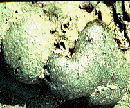 |
"Black,
colonial tunicate"
| Phylum |
Chordata |
| Class |
Ascidiacea |
| Order |
Enterogena |
| Family |
Polyclinidae |
|
| Morphology |
Generally
forms a smooth, raised colony, dark brown to black, with yellow
to white individuals arranged in oval or circular groups. Usually
5 - 10 cm across. Individually they are transparent, stiff,
and are covered by a jellylike tunic. |
| Feeding |
Filter small
particles from the water using a sticky, basket-like pharynx. |
| Defense |
Produce distasteful
biochemicals |
| Reproduction |
Produce planktonic
"tadpole" larvae that have chordate characteristics. |
| Habitat |
Live on the
surfaces or undersides of rocks |
| Distribution |
Gulf of California |
| Other |
Common inhabitant
of Puerto Penasco. |
|
|









